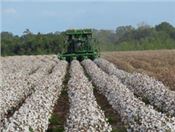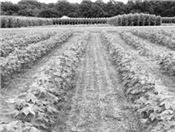LSU AgCenter Project Examines Benefits, Challenges Of Wider Cotton Rows

A grower in Tensas Parish picks cotton that was grown on 60-inch rows this fall.
Photo by Dennis Burns/LSU AgCenter
ST. JOSEPH, LA.
An LSU AgCenter project is examining the benefits and challenges of growing cotton on wider rows that line up with configurations used for other crops, potentially saving farmers money.
Cotton rows are typically either 38 or 40 inches wide. But interest is growing in 60-inch rows, and the AgCenter as well as two northeast Louisiana farmers gave it a try this year.
“Both of these producers did it because they grow corn and soybeans,” said Dennis Burns, an AgCenter agent and research coordinator at the Northeast Research Station near St. Joseph. The producers grow those crops on 30-inch rows on 60-inch beds.
“Instead of having two sets of equipment, they wanted to be able to have one set of rows,” Burns explained. “On this wide bed, they plant the corn and soybeans on the side of the bed, and then the cotton comes in the middle of the bed. It gives them some flexibility.”
At the Northeast Research Station, Burns conducted a trial where cotton was planted on 40- and 60-inch rows, both with and without cover crops.
“The reason for the cover crop was we were concerned somewhat about weed control with those wide middles,” he said. “Turned out, weed control was not as big of an issue as we thought. The residual herbicides helped us with that.”
All of the cotton received the same nitrogen fertilizer and plant growth regulator, or PGR, treatments.
The cotton grown on 40-inch rows was a few inches taller than the 60-inch-row cotton, which expanded outward and lapped into the middles, Burns said. These differences in height and growth habit can affect yields.
Burns sees two key results from this initial study. “You’ve got to pick the right variety,” he said, and wide rows may need higher nitrogen rates and multiple, smaller PGR applications.
Burns plans to study wide rows in greater depth next year. He wants to look into how well they perform on different soil types and gather data for an economic analysis of the practice. ∆

Cotton grows on 60-inch rows with a cover crop early in the 2020 growing season at the
LSU AgCenter Northeast Research Station.
Photo by Dennis Burns/LSU AgCenter